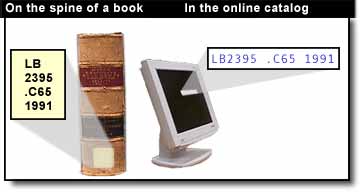
Libraries use classification systems to organize the books on the shelves. A classification system uses letters and/or numbers (call numbers) to arrange the books so that books on the same topic are together. This arrangement results in "serendipitous browsing:" you find one book in the catalog, go to the shelf, and, an even better book is sitting right next to it.
Libraries in the United States generally use either the Library of Congress Classification System (LC) or the Dewey Decimal Classification System to organize their books. Most academic libraries use LC, and most public libraries and K-12 school libraries use Dewey.

Tips for Finding Books on the Shelf:
Call numbers are read line by line.
LB
Read the first line in alphabetical order:
A, B, BF, C, D... L, LA, LB, LC, M, ML...
2395
Read the second line as a whole number:
1, 2, 3, 45, 100, 101, 1000, 2000, 2430...
.C65
The third line is a combination of a letter and numbers. Read the letter alphabetically. Read the number as a decimal, eg:
.C65 = .65 .C724 = .724
Some call numbers may have more than one combination letter-number line.
1991
The last line is the year the book was published. Read in chronological order:
1985, 1991, 1992...
Below is a sequence of books with the call number order explained:
